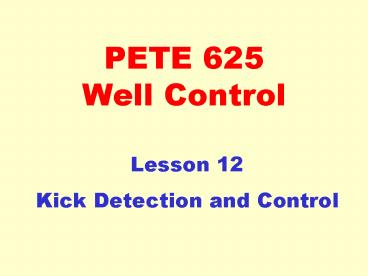PETE 625 Well Control PowerPoint PPT Presentation
1 / 50
Title: PETE 625 Well Control
1
PETE 625Well Control
- Lesson 12
- Kick Detection and Control
2
Kick Detection and Control
- Primary and Secondary Well Control
- What Constitutes a Kick
- Why Kicks Occur
- Kick Detection Methods
- Shut-in Procedures
3
Assignments
- HW 7 Ch 3, Problems 11- 20
- due Monday, June 28
- HW 8 Ch 4, Problems 1- 10
- due Friday, July 2
- Read Chapter 4 to p.154
4
Kick Detection and Control
- The focus of well control theory is to contain
and manage formation pressure. - Primary well control involves efforts at
preventing formation fluid influx into the
wellbore (avoiding kicks). - Secondary well control involves detecting and
bringing an influx to the surface.
5
Kicks
- A kick may be defined as an unscheduled influx of
formation fluids. - Fluids produced during underbalanced drilling are
not considered kicks - Fluids produced during a DST are not considered
kicks
6
Kicks
- For a kick to occur, we need
- Wellbore pressure lt pore pressure
- A reasonable level of permeability
- A fluid that can flow
p 0.052 MW Vertical Depth po
7
Kicks
- Kicks may occur while
- Drilling
- Tripping
- Making a connection
- Logging
- Running Casing
- Cementing
- N/U or N/D BOP, etc.
8
Causes of Kicks
- Insufficient wellbore fluid density
- Low drilling or completion fluid density
- Reducing MW too much
- Drilling into abnormally pressured formations
- Temperature expansion of fluid
- Excessive gas cutting
p 0.052 MW Vertical Depth po
9
Causes of Kicks
- Reduction of height of mud column
- Lost circulation because of excess static or
dynamic wellbore pressure - Fluid removal because of swabbing
- Tripping pipe without filling the hole
p 0.052 MW Vertical Depth po
10
Causes of Kicks
- Excessive swab friction pressure while moving
pipe - Wellbore collision between a drilling and
producing well - Cement hydration
11
Kick indicators
- Indicator
- Drilling break
- Increase in mud return rate
- Pit gain
- Flow w/ pumps off
- Significance
- Medium
- High
- High
- Definitive
12
Kick indicators
- Indicator
- Pump pressure decrease and rate increase
- Increase in drillstring weight
- Gas cutting or salinity change
- Significance
- Low
- Low
- Low
13
Kick Influx Rate
- This equation would rarely be strictly applicable
in the event of a kick since fluid
compressibility is not considered and transient
relationships better describe influx flow
behavior.
14
Kick Influx Rate
- Extremely important to detect a kick early, to
minimize its size. - If a kick is suspected,
run a flow check!!!
15
Circulation path for Drilling Fluid What goes in
Must come out unless a kick occurs
As drilling proceeds, mud level in pit drops
slowly. Why?
16
Set alarm for high or low flow rate
If a kick occurs, flow rate from the well
increases - an early indicator
17
Pit Volume Totalizer, PVT shows pit gain or
loss. Pit level is a good kick indicator
System should detect a 10 bbl kick under most
conditions onshore
18
Kick size
- Under most conditions a 10 bbl kick can be
handled safely. - An exception is slimhole drilling, where even a
small kick occupies a large height in the
annulus. - In floating drilling, where the vessel moves,
small kicks are more difficult to detect
19
Mud pulse telemetry - pressure pulses detected at
the surface
20
Acoustic kick detection
Gas in the annulus will attenuate a pressure
signal, and will reduce the velocity of sound in
the mud
21
Minimum kick size that can be detected by an
acoustic system
22
Delta flow indicator
23
Delta flow indicator
Delta flow qout - qin
24
Delta flow indicator
25
BOP stack
26
BOP stack
27
DP TJ DC OH Press
Annular Blowout Preventer
28
Ram Blowout Preventer
29
SHEAR / BLIND RAM ASSEMBLY
Ram Blowout Preventer - contd
30
BOP Control Panel
31
Choke Manifold
32
Choke Manifold
33
Choke panel
34
Choke panel
35
If a kick is suspected
- Lift the drillstring until a tool joint is just
above the rotary table - Shut down the mud pumps
- Check for flow
36
If a kick is suspected
- If flowing - shut the annular, open the HCR
valve, and close the choke - Record SIDPP and SICP
- Record pit gain and depth (MD and TVD)
- Note the time
37
Kick Detection and Control
- Shut-in Procedures
- Soft Shut-in
- Hard Shut-in
- Water Hammer
38
Hard Shut-In
39
Hard Shut-In
Water hammer?
40
Water Hammer
- Water hammer is an increase in pressure caused
by rapid change in the fluids kinetic energy
which, in a shut-in procedure, results from
closing a preventer or choke on the flowing mud. - The shock wave created by the closed valve
propagates to the bottom of the hole at the speed
of sound, and then returns to the surface at the
same speed.
41
Soft Shut-In
42
Soft Shut-In
Larger Kick
43
Example 4.1
44
Example 4.1
Eq. 4.2
45
Example 4.1 - Solution
(lt 5 sec)
46
Water Hammer
47
Water Hammer
48
Water Hammer
49
Differential Sticking
50
Shut-in Data
The final step in this phase of the operation is
to measure accurately the pit gain. Precise
pit-volume measurements are hard to come by, even
under ideal conditions.

